| J Mult Scler Neuroimmunol > Volume 15(1); 2024 > Article |
|
ABSTRACT
Inflammatory diseases of the central nervous system (CNS) include multiple sclerosis (MS), neuromyelitis optica spectrum disorder (NMOSD), myelin oligodendrocyte glycoprotein antibody-associated disease (MOGAD), and acute disseminated encephalomyelitis. In addition, various rheumatoid autoimmune diseases, autoimmune encephalitis, and medications such as immune checkpoint inhibitors can cause inflammation in the CNS. Radiological findings are very useful for us in differentiating inflammatory diseases of the CNS. On MRI, the shape, location, length/size, and gadolinium enhancement pattern of the lesions as well as the recovery and atrophy of the lesions following the acute phase, serve as important biomarkers for differentiating the diseases. In this review, we will highlight the typical characteristics MRI of optic neuritis, brain lesions, and myelitis in MS, NMOSD, and MOGAD, and outline the features of other inflammatory diseases of CNS.
ņżæņČöņŗĀĻ▓ĮĻ│ä ņŚ╝ņ”Øņä▒ ņ¦łĒÖśņŚÉļŖö ļīĆĒæ£ņĀüņ£╝ļĪ£ ļŗżļ░£Ļ▓ĮĒÖöņ”Ø, ņŗ£ņŗĀĻ▓Įņ▓ÖņłśņŚ╝, ĒĢŁņłśņ┤łĒؼņåīļÅīĻĖ░ņĢäĻĄÉņäĖĒżļŗ╣ļŗ©ļ░▒ņ¦łĒĢŁņ▓┤ Ļ┤ĆļĀ© ņ¦łĒÖś(myelin oligodendrocyte glycoprotein antibody-associated disease, MOGAD)Ļ│╝ ņåīņĢäņŚÉņä£ ĒØöĒĢ£ ĻĖēņä▒Ēīīņóģņä▒ļćīņ▓ÖņłśņŚ╝(acute disseminated encephalomyelitis, ADEM)ņØ┤ ņ׳ņ£╝ļ®░, ĻĘĖ ņÖĖņŚÉļÅä ņĀäņŗĀĒÖŹļ░śļŻ©ĒæĖņŖżņØ┤ļéś ņć╝ĻĘĖļĀīņ”ØĒøäĻĄ░, ļ▓Āņ▓┤ĒŖĖļ│æ, ņé¼ļź┤ņĮöņØ┤ļō£ņ”Ø ļō▒ļÅä ņżæņČöņŗĀĻ▓ĮĻ│äļź╝ ņ╣©ļ▓öĒĢĀ ņłś ņ׳ļŗż.1 ĻĘĖ ņÖĖņŚÉļÅä ņ×ÉĻ░Ćļ®┤ņŚŁ ļćīņŚ╝ņØ┤ļéś ņØ╝ļČĆ Ļ░ÉņŚ╝ņä▒ ņ¦łĒÖśņØ┤ļéś ļīĆņé¼ņä▒ ņ¦łĒÖśņŚÉ ņØśĒĢ┤ņä£ļÅä ņżæņČöņŗĀĻ▓ĮĻ│ä ņŚ╝ņ”Øņä▒ ņ¦łĒÖśņØä ņ£Āļ░£ļÉĀ ņłś ņ׳ņ£╝ļ®░, ņĄ£ĻĘ╝ņŚÉļŖö ļ®┤ņŚŁĻ┤Ćļ¼Ė ņ¢ĄņĀ£ņĀ£(immune checkpoint inhibitors)ņŚÉ ņØśĒĢ£ ļ│┤Ļ│ĀļÅä ņ׳ļŗż.2 ņ×äņāü ņ¢æņāüĻ│╝ ļ│æļĀź, ņŗĀĻ▓ĮĒĢÖņĀü ņ¦äņ░░ņØĆ ņ¦äļŗ©ņŚÉ ļ¦żņÜ░ ņżæņÜöĒĢśļéś ļĢīļĪ£ļŖö ņĀ£ĒĢ£ņĀüņØ╝ ņłś ņ׳ņ¢┤ņä£, Ļ░ü ņ¦łĒÖśļ│ä ņśüņāüĒĢÖņĀü ĒŖ╣ņ¦ĢĻ│╝ ņ░©ņØ┤ļź╝ ņĢäļŖö Ļ▓āņØ┤ ņżæņČöņŗĀĻ▓ĮĻ│ä ņŚ╝ņ”Øņä▒ ņ¦łĒÖśļōżņØś Ļ░Éļ│ä ņ¦äļŗ©ņŚÉ ĒĢäņÜöĒĢśĻ▓Āļŗż. ņØ┤ ļģ╝ļ¼ĖņŚÉņä£ļŖö ļŗżļ░£Ļ▓ĮĒÖöņ”Ø, ņŗ£ņŗĀĻ▓Įņ▓ÖņłśņŚ╝ņÖĆ MOGADņŚÉņä£ ļ░£ņāØĒĢśļŖö ņŗ£ņŗĀĻ▓ĮņŚ╝, ļćīļ│æļ│Ć ļ░Å ņ▓ÖņłśņŚ╝ņØś ņ×ÉĻĖ░Ļ│Ąļ¬ģņśüņāü(MRI)ņØś ĒŖ╣ņ¦ĢņØä ņżæņĀÉņ£╝ļĪ£ ņé┤ĒÄ┤ļ│┤Ļ│Ā, ļŗżņ¢æĒĢ£ ņżæņČöņŗĀĻ▓ĮĻ│ä ņŚ╝ņ”Øņä▒ ņ¦łĒÖśņØś ĒŖ╣ņ¦ĢņĀüņØĖ ņåīĻ▓¼ļōżņØä Ļ░äļץĒ׳ ņåīĻ░£ĒĢśĻ│Āņ×É ĒĢ£ļŗż.
ņŗ£ņŗĀĻ▓ĮņŚ╝ņØĆ ļŗżļ░£Ļ▓ĮĒÖöņ”ØņŚÉņä£ ņ┤łĻĖ░ ņ”Øņāüņ£╝ļĪ£ 25%, ņĀäņ▓┤ ņ¦łļ│æ Ļ▓ĮĻ│╝ņØś 70%Ļ╣īņ¦Ć ņ░©ņ¦ĆĒĢśĻ│Ā ņŗ£ņŗĀĻ▓Įņ▓ÖņłśņŚ╝Ļ│╝ MOGADņŚÉņä£ļÅä ĒØöĒĢśĻ▓ī ļ░£ņāØĒĢśļ®░, ņŗ£ļĀź ņĀĆĒĢśņÖĆ ņāēĻ░ü Ļ░Éņåī, ņŗ£ņĢ╝ņןņĢĀņØś ņ”ØņāüņØä ļÅÖļ░śĒĢ£ļŗż.3 ļŗżļ░£Ļ▓ĮĒÖöņ”ØņŚÉņä£ ļ░£ņāØĒĢśļŖö ņŗ£ņŗĀĻ▓ĮņŚ╝ņØś ņĀäĒśĢņĀüņØĖ ņśüņāüĒĢÖņĀü ņåīĻ▓¼ņØĆ ļ│æļ│ĆņØ┤ ņŻ╝ļĪ£ ĒÄĖņĖĪņ£╝ļĪ£ ļ░£ņāØĒĢśĻ│Ā, ļīĆļČĆļČä canalicular segmentņŚÉ ņ£äņ╣śĒĢśļ®░, ļ│æļ│ĆņØś ĻĖĖņØ┤Ļ░Ć ņĀäņ▓┤ ņŗ£ņŗĀĻ▓ĮņØś 1/2 ļ»Ėļ¦īņ£╝ļĪ£ ņ¦¦ļŗż(Fig. 1, Table 1). ņŖżņø©ļŹ┤ ņŚ░ĻĄ¼ņŚÉņä£ 472ļ¬ģņØś ļŗżļ░£Ļ▓ĮĒÖöņ”Ø ĒÖśņ×ÉļōżņØä ļ│┤Ļ│ĀĒĢ£ ļ░öņŚÉ ļö░ļź┤ļ®┤ ņĢĮ 21%ņŚÉņä£ ņ▓½ ņ”Øņāüņ£╝ļĪ£ ņŗ£ņŗĀĻ▓ĮņŚ╝ņØ┤ ļ░£ņāØĒĢśņśĆĻ│Ā, ņĀäņ▓┤ Ļ▓ĮĻ│╝ ņżæņŚÉ ņ¢æņĢł ļ¬©ļæÉ ņŗ£ņŗĀĻ▓ĮņŚ╝ņØ┤ ļ░£ņāØĒĢ£ Ļ▓ĮņÜ░ļŖö ņĢĮ 5.5%ņśĆņ£╝ļéś ļÅÖņŗ£ņŚÉ ņ¢æņĖĪ ņŗ£ņŗĀĻ▓ĮņŚ╝ņØ┤ ļ░£ņāØĒĢśļŖö Ļ▓ĮņÜ░ļŖö 0.42%ļĪ£ ļ¦żņÜ░ ļō£ļ¼╝Ļ▓ī ļ│┤Ļ│ĀļÉśņŚłļŗż. ņØ┤ņŚÉ ļ░śĒĢ┤ ņŗ£ņŗĀĻ▓Įņ▓ÖņłśņŚ╝Ļ│╝ MOGADņŚÉņä£ļŖö ņĢĮ 30-35%ņŚÉņä£ ļÅÖņŗ£ņŚÉ ņ¢æņĖĪ ņŗ£ņŗĀĻ▓ĮņŚ╝ņØ┤ ļ░£ņāØĒĢśļŖö Ļ▓āņ£╝ļĪ£ ļéśĒāĆļé¼ņ£╝ļ®░, ļ│æļ│ĆņØś ĻĖĖņØ┤ļÅä ņĀäņ▓┤ ņŗ£ņŗĀĻ▓ĮņØś 1/2ļ│┤ļŗż ĻĖ┤ ļ│æļ│ĆņØä Ļ░Ćņ¦ĆļŖö Ļ▓ĮņÜ░Ļ░Ć ļ¦Äļŗż(Figs. 2, 3). ņĢłĻĄ¼ MRIņŚÉņä£ ņŗ£ņŗĀĻ▓Į ņ▓ÖņłśņŚ╝ņØ┤ļéś MOGADņØś ņŗ£ņŗĀĻ▓ĮņŚ╝ ļ│æļ│Ć ĻĖĖņØ┤ļŖö ļŗżļ░£Ļ▓ĮĒÖöņ”ØņŚÉ ļ╣äĒĢ┤ ņĢĮ 2-3ļ░░ņØś ĻĖĖņŚłļŗż.4,5 ņŗ£ņŗĀĻ▓ĮņŚ╝ņØś ĒśĖļ░£ ļČĆņ£äļÅä ņ¦łļ│æ Ļ░ä ņ░©ņØ┤ļź╝ ļ│┤ņØ┤ļŖöļŹ░, ņŗ£ņŗĀĻ▓ĮĻĄÉņ░©(optic chiasm)ļź╝ ņ╣©ļ▓öĒĢśļŖö Ļ▓ĮņÜ░Ļ░Ć ļŗżļ░£Ļ▓ĮĒÖöņ”ØņØ┤ļéś MOGADņŚÉņä£ļŖö 2-15%ņśĆņ£╝ļéś ņŗ£ņŗĀĻ▓Įņ▓ÖņłśņŚ╝ņØś Ļ▓ĮņÜ░ ņĢĮ 64%ļĪ£ ļ¦żņÜ░ ļåÆĻ▓ī ļéśĒāĆļé¼ļŗż. MOGADņŚÉņä£ļŖö ņāüļīĆņĀüņ£╝ļĪ£ ņŗ£ņŗĀĻ▓Į ņĢ×ņ¬ĮļČäņĀłņØä ņ╣©ļ▓öĒĢśļŖö Ļ▓ĮņÜ░Ļ░Ć ļ¦ÄņĢśņ£╝ļ®░, ņŗ£ņŗĀĻ▓Į ņ£ĀļæÉ ļČĆņóģļÅä ļ¦ÄĻ▓īļŖö ņĢĮ 50%ņŚÉņä£ ļ│┤Ļ│ĀļÉśņŚłļŗż. ļśÉĒĢ£ ņĪ░ņśüņ”ØĻ░Ģ ņśüņāüņŚÉņä£ ņŗĀĻ▓ĮņŻ╝ņ£ä ņĪ░ņśüņ”ØĻ░Ģ(perineural enhancement)ņØ┤ Ļ┤Ćņ░░ļÉĀ ņłś ņ׳ļŗż(Fig. 3, Table 1).
ņ×ÉĻĖ░Ļ│Ąļ¬ģņśüņāüņØś ĒŖ╣ņłśĻĖ░ļ▓Ģņ£╝ļĪ£ ņ¢╗ņØĆ ņ×ÉĻĖ░ĒÖöņĀäļŗ¼ļ╣äņ£©(magnetization transfer ratio, MTR)ļÅä ņ¦łĒÖśļōżņØś Ļ░Éļ│äņŚÉ ļÅäņøĆņØ┤ ļÉśļŖö ļŹ░, ņØ┤ļŖö ņ×ÉĻĖ░ĒÖöņĀäļŗ¼ĒīīņŚÉ ļīĆĒĢ┤, ņ×Éņ£ĀļĪ£ņØ┤ ņøĆņ¦üņØ┤ļŖö ļ¼╝ļČäņ×ÉņÖĆ ņłśņ┤ł(myelin) Ēś╣ņØĆ ņČĢņéŁļ¦ē(axon membrane)ņŚÉ ļČÖņ¢┤ ņ׳ļŖö ņāüĒā£ņØś ļ¼╝ļČäņ×ÉĻ░Ć ļŗżļźĖ ĒŖ╣ņä▒ņØä ļ│┤ņØ┤ļŖö Ļ▓āņØä ņØ┤ņÜ®ĒĢśņŚ¼ Ļ│äņé░ĒĢ£ Ļ▓āņØ┤ļŗż. ļćīņ▓ÖņłśņĢĪņŚÉņä£ļŖö MTRņØ┤ 0ņŚÉ ņłśļĀ┤ĒĢśļ®░, ņĀĢņāü ļćīņĪ░ņ¦üņŚÉņä£ļŖö ņĢĮ 40-50ņØä ļ│┤ņØ┤ļŖöļŹ░, ņŗĀĻ▓Į ņåÉņāüņØ┤ ļ░£ņāØĒĢśļ®┤ MTRņØ┤ Ļ░ÉņåīĒĢ£ļŗż.6 ļŗżļ░£Ļ▓ĮĒÖöņ”ØņŚÉņä£ ņŗ£ņŗĀĻ▓ĮņŚ╝ņØ┤ ļ░£ņāØĒĢ£ Ļ▓ĮņÜ░ ļ│æļ│Ć ļČĆņ£äņØś MTRņØ┤ ņ”Øņāü ļ░£ņāØ 8Ļ░£ņøö ļÆż Ļ░Ćņן ļé«Ļ│Ā(nadir) ņØ┤Ēøä ņä£ņä£Ē׳ ĒśĖņĀäļÉśļŖö ņČöņØ┤ļź╝ ļ│┤ņØĖļŗż.7 ļŗżļ░£Ļ▓ĮĒÖöņ”ØņŚÉ ļ╣äĒĢ┤ ņŗ£ņŗĀĻ▓Įņ▓ÖņłśņŚ╝ņØ┤ļéś MOGADņŚÉņä£ļŖö MTRņØś Ļ░ÉņåīĻ░Ć ļŹö ņŗ¼ĒĢ£ Ļ▓āņ£╝ļĪ£ ļéśĒāĆļé¼ļŗż.8
ņĢłĻĄ¼ļ╣øĻ░äņäŁļŗ©ņĖĄņ┤¼ņśü(optical coherence tomography, OCT)ņØĆ ļ¦Øļ¦ē ņŗ£ņŗĀĻ▓ĮņĖĄņØś ļæÉĻ╗śļź╝ ĒÅēĻ░ĆĒĢśļŖö ļŹ░ ņØ┤ņÜ®ĒĢĀ ņłś ņ׳ņ£╝ļ®░, ņŗĀĻ▓ĮņĀłņäĖĒż(ganglion cell)ņØś ņČĢņéŁņØ┤ ļ¬©ņØ┤ļŖö ņŗ£ņŗĀĻ▓Įņ£ĀļæÉņØś ļ¦Øļ¦ēņŗĀĻ▓Įņä¼ņ£ĀņĖĄ(retinal nerve fiber layer, RNFL)Ļ│╝ ĒÖ®ļ░ś ņŗĀĻ▓ĮņĀłņäĖĒż-ļé┤ļ¦ØņāüņĖĄ(ganglion cell-inner plexiform layer, GCIP)ņØś ļæÉĻ╗śļź╝ ņŻ╝ļĪ£ ņĖĪņĀĢĒĢ£ļŗż.9 ņŗ£ņŗĀĻ▓ĮņŚ╝ ĻĖēņä▒ĻĖ░ņŚÉļŖö ļ¦Øļ¦ē ļČĆņóģņ£╝ļĪ£ ņØĖĒĢ┤ OCTņŚÉņä£ ņŗ£ņŗĀĻ▓ĮņĖĄņØ┤ ļæÉĻ║╝ņøīņ¦ä Ļ▓āņØ┤ Ļ┤Ćņ░░ļÉ£ļŗż. ņŗ£ņŗĀĻ▓ĮņŚ╝ņØ┤ ļ░£ņāØĒĢ£ MOGADņØś 31Ļ░£ņÖĆ ļŗżļ░£Ļ▓ĮĒÖöņ”ØņØś 48Ļ░£ ļłłļōżņØä ņĀĢņāüņĖĪ ļłłņŚÉ ļ╣äĻĄÉĒĢśņśĆņØä ļĢī, GCIP ļæÉĻ╗śļŖö ņ░©ņØ┤Ļ░Ć ņŚåņŚłņ£╝ļéś RNFLņØś ļæÉĻ╗śļŖö ņ£ĀņØśĒĢśĻ▓ī ļæÉĻ║╝ņøīņĀĖ ņ׳ņ£╝ļ®░, ĒŖ╣Ē׳ MOGADņŚÉņä£ļŖö RNFLņØś ņżæņĢÖĻ░ÆņØ┤ 45 ╬╝m (interquartile rage [IQR], 17-105)ļĪ£ ļŗżļ░£Ļ▓ĮĒÖöņ”Ø(ņżæņĢÖĻ░Æ, 7.5; IQR, 1-18)ņŚÉ ļ╣äĒĢ┤ ņĢĮ 6ļ░░ ļåÆņĢśļŗż.10 ļ╣øĻ░äņäŁļŗ©ņĖĄĒśłĻ┤ĆņĪ░ņśüņłĀ(OCT angiography)ņŚÉņä£ļŖö ļŗżļ░£Ļ▓ĮĒÖöņ”ØņØ┤ļéś ņŗ£ņŗĀĻ▓Į ņ▓ÖņłśņŚ╝ņŚÉņä£ ļ│æļ│ĆņĖĪ ļłłņØ┤ ņĀĢņāüņĖĪ ļłłņŚÉ ļ╣äĒĢ┤ ņ£ĀļæÉņŻ╝ļ│Ćļ¬©ņäĖĒśłĻ┤Ćņ┤Ø(peripapillary capillary plexus)ņØś ļ░ĆļÅäĻ░Ć Ļ░ÉņåīĒĢśņśĆņ£╝ļ®░, ņØ┤ļŖö ņŗ£ņŗĀĻ▓Įņ▓ÖņłśņŚ╝ņŚÉņä£ ļŹöņÜ▒ ļÜ£ļĀĘĒĢśņśĆļŗż.11
ļŗżļ░£Ļ▓ĮĒÖöņ”ØņØĆ 2017 McDonald ņ¦äļŗ© ĻĖ░ņżĆņŚÉņä£ ļćīļ│æļ│ĆņØĆ ņ¦äļŗ©ņŚÉ ĒĢäņłśņĀüņØ┤ļ®░, Ēö╝ņ¦ł/Ēö╝ņ¦łĻ│ü(cortical/juxtacortical), ļćīņŗżņŻ╝ņ£ä(periventricular), ņ▓£ļ¦ēļ░æ(infratentorial)ņŚÉ Ēāłņłśņ┤ł ļ│æļ│ĆņØ┤ ĒÖĢņØĖļÉśļŖö Ļ▓ĮņÜ░ļĪ£ ņĀ£ņŗ£ļÉśņŚłļŗż(Fig. 4, Table 2).12 ņĀäĒśĢņĀüņØĖ ļ│æļ│ĆņØś Ļ▓ĮņÜ░, Ļ▓ĮĻ│äĻ░Ć ļ¬ģĒÖĢĒĢ£ ĒāĆņøÉ Ēś╣ņØĆ ņøÉĒśĢ ļ¬©ņ¢æņØ┤ļ®░, ņĪ░ņśüņ”ØĻ░Ģ ņśüņāüņŚÉņä£ ĻĘĀņ¦łĒĢśĻ▓ī ņĪ░ņśüņ”ØĻ░ĢļÉśĻ▒░ļéś Ļ│Āļ”¼(ring) Ēś╣ņØĆ ņŚ┤ļ”░Ļ│Āļ”¼(open-ring)ļĪ£ ļéśĒāĆļé£ļŗż.13,14 Ļ░Ćņ¬Įļćīņŗż ņŻ╝ņ£äņŚÉ ļ│æļ│ĆņØ┤ ļ░£ņāØĒĢśļ®┤ ņåÉĻ░ĆļØĮņØś ļ¬©ņ¢æĻ│╝ ņ£Āņé¼ĒĢśņŚ¼ DawsonŌĆÖs fingerļØ╝Ļ│ĀļÅä ĒĢ£ļŗż. ļ│æļ│ĆņØ┤ ļ░£ņāØĒ¢łļŹś ļČĆņ£äņŚÉļŖö ņŗ£Ļ░äņØ┤ ņ¦Ćļéśļ®┤ ņĪ░ņ¦ü ņåīņŗż(tissue loss)ļĪ£ ņØĖĒĢ┤ T1 Ļ░ĢņĪ░ņśüņāüņŚÉņä£ Ļ▓ĆĻ▓ī ļ│┤ņØ┤ļŖö Ļ▓ĆņØĆĻĄ¼ļ®Ź(T1-black hole)ņØ┤ Ļ┤Ćņ░░ļÉĀ ņłś ņ׳ļŗż(Fig. 4D). ļśÉĒĢ£, ņĢäļלņĖĪļæÉņŚĮ ļćīņŗż ņŻ╝ļ│ĆņŚÉ ļ│æļ│ĆņØ┤ ņāØĻĖ░ļŖö Ļ▓ĮņÜ░ ļŗżļ░£Ļ▓ĮĒÖöņ”ØņØś Ļ░ĆļŖźņä▒ņØä ņóĆ ļŹö ņŗ£ņé¼ĒĢ£ļŗż(Fig. 4B).
ļŗżļ░£Ļ▓ĮĒÖöņ”ØĻ│╝ ļŗ¼ļ”¼ ņŗ£ņŗĀĻ▓Įņ▓ÖņłśņŚ╝ņØ┤ļéś MOGADņŚÉņä£ļŖö ņ¦äļŗ©ņŚÉ ļćīļ│æļ│ĆņØ┤ ĒĢäņłśņĀüņØ┤ņ¦ĆļŖö ņĢŖņ£╝ļ®░, ļćīļ│æļ│ĆņØś ņ£Āļ¼┤ļŖö ņ¦äļŗ© ņŗ£ Ļ░üĻ░ü 23-30%ņÖĆ 27-44%ļĪ£ ļ│┤Ļ│ĀļÉśņŚłļŗż.8,15 ņŗ£ņŗĀĻ▓Įņ▓ÖņłśņŚ╝ņŚÉņä£ ļćīļ│æļ│ĆņØĆ ņŻ╝ļĪ£ ļćīņŗż ņŻ╝ļ│ĆņØä ļö░ļØ╝ ļ░£ņāØĒĢśļŖöļŹ░, ņĀ£3ļćīņŗżĻ│╝ ļīĆļćīņłśļÅä, ņŗ£ņāü, ņŗ£ņāüĒĢśļČĆ, ņĀ£4ļćīņŗż ņŻ╝ļ│ĆņØś ļćīĻ░äņŚÉ ĒśĖļ░£ĒĢśļ®░, ļ¦©ņĢäļלĻĄ¼ņŚŁ(area postrema)ņØä ĒżĒĢ©ĒĢ£ ļō▒ņ¬Įņł©ļćī(dorsal medulla)ņŚÉ ņāØĻĖ┤ ļ│æļ│ĆņØĆ Ļ▓ĮņłśĻ╣īņ¦Ć ņØ┤ņ¢┤ņ¦ĆĻĖ░ļÅä ĒĢ£ļŗż(Fig. 5).16 Ļ░ĆņĖĪļćīņŗż ņŻ╝ļ│Ć ļćīļ¤ē ļ│æļ│Ć(callosal lesion)ņØĆ ļćīņŗżļ¦ēļé┤ņĖĄ(ependymal lining)ņØä ļö░ļØ╝ ļ░£ņāØĒĢśņŚ¼ ŌĆśmarbleŌĆÖ Ēś╣ņØĆ ŌĆśarch bridge patternŌĆÖņØ┤ļØ╝ ĒĢ£ļŗż. ļ│æļ│ĆņØś ļ¬©ņ¢æņØĆ ļŗżļ░£Ļ▓ĮĒÖöņ”ØĻ│╝ ļŗ¼ļ”¼ ņל ņĀĢĒśĢĒÖöļÉśņ¦Ć ņĢŖņ£╝ļ®░, ĒśłĻ┤Ćņä▒ ļČĆņóģ(vasogenic edema)ņØä ļÅÖļ░śĒĢśĻ▒░ļéś ņóģĻ┤┤ņ¢æ(tumefactive) ļ¬©ņŖĄņ£╝ļĪ£ ļ│┤ņØ╝ ņłś ņ׳Ļ│Ā, ļ¦īņä▒ĒÖöļÉ£ Ļ▓ĮņÜ░ ļéŁņóģņ£Āņé¼ Ļ│ĄļÅÖ ļ│ĆĒÖö(cystic-like cavity change)Ļ░Ć ļÅÖļ░śļÉĀ ņłś ņ׳ļŗż. ļśÉĒĢ£, ĒÄĖņĖĪ Ēś╣ņØĆ ņ¢æņĖĪ Ēö╝ņ¦łņ▓ÖņłśļĪ£ļź╝ ļö░ļØ╝ ļ│æļ│ĆņØ┤ ņāØĻĖ░ļŖö Ļ▓ĮņÜ░ ņŗ£ņŗĀĻ▓Įņ▓ÖņłśņŚ╝ņØś Ļ░ĆļŖźņä▒ņØä ņŗ£ņé¼ĒĢ£ļŗż. ņĪ░ņśüņ”ØĻ░ĢņØĆ cloud-like Ēś╣ņØĆ linearĒĢ£ ņ¢æņāüņØ┤ļ®░, ļćīņłśļ¦ē ņĪ░ņśüņ”ØĻ░ĢļÅä ļÅÖļ░śļÉĀ ņłś ņ׳ļŗż(Table 2). MOGADņŚÉņä£ ļćīļ│æļ│ĆņØĆ ADEMĻ│╝ ņ£Āņé¼ĒĢśĻ▓ī ļéśĒāĆļéśļ®░, ļ░▒ņ¦ł, Ļ╣ŖņØĆĒÜīņāēņ¦ł, ņåīļćīņżæĻ░äļŗżļ”¼, ļćīĻ░ä, Ēö╝ņ¦łņŚÉ ļ│æļ│ĆņØś Ļ▓ĮĻ│äĻ░Ć ļČłļ¬ģĒÖĢĒĢśĻ│Ā ņ£ĄĒĢ®ņä▒(confluent) ļ│æļ│ĆņØ┤ Ļ┤Ćņ░░ļÉ£ļŗż(Fig. 6).17 ņĪ░ņśüņ”ØĻ░ĢņØĆ ļÅÖļ░śļÉśņ¦Ć ņĢŖĻĖ░ļÅä ĒĢśĻ│Ā, ĒÄĖņĖĪ Ēś╣ņØĆ ņ¢æņĖĪ Ēö╝ņ¦ł ņŚ░ņłśļ¦ē ņĪ░ņśüņ”ØĻ░ĢņØä ļéśĒāĆļéśĻĖ░ļÅä ĒĢ£ļŗż.
ņØ┤ļ¤¼ĒĢ£ ļ│æļ│ĆņØś ņ£äņ╣śļéś ļ¬©ņ¢æņØĆ ņ¦łļ│æļōżņØä ņä£ļĪ£ ĻĄ¼ļČäĒĢśļŖö ļŹ░ ļ¦żņÜ░ ņżæņÜöĒĢ£ ĻĖ░ņżĆņØ┤ ļÉ£ļŗż(Table 2). ņĢäļלņĖĪļæÉņŚĮ ļćīņŗż ņŻ╝ņ£ä ļ│æļ│ĆĻ│╝ Uņä¼ņ£Ā ļ│æļ│Ć, DawsonŌĆÖs finger ļ¬©ļæÉ ļÅÖļ░śĒĢśļŖö Ļ▓ĮņÜ░ņŚÉļŖö ņŗ£ņŗĀĻ▓Į ņ▓ÖņłśņŚ╝Ļ│╝ MOGADņŚÉ ļ╣äĒĢ┤ ļŗżļ░£Ļ▓ĮĒÖöņ”ØņŚÉ ļīĆĒĢ£ ņ¢æņä▒ņśłņĖĪļźĀņØ┤ Ļ░üĻ░ü 90.3%ņÖĆ 97.6%ļĪ£ ļ¦żņÜ░ ļåÆĻ▓ī ļéśĒāĆļé¼ļŗż.18 Ēö╝ņ¦ł ļ│æļ│ĆņØś ņ£Āļ¼┤ļÅä ļŗżļ░£Ļ▓ĮĒÖöņ”ØĻ│╝ ļŗżļźĖ ņżæņČöņŗĀĻ▓ĮĻ│ä ņŚ╝ņ”Øņä▒ ņ¦łĒÖśļōżņØä ĻĄ¼ļČäĒĢśļŖö ļŹ░ ļÅäņøĆņØ┤ ļÉ£ļŗż. Ēö╝ņ¦ł ļ│æļ│ĆņØĆ ĒśĢĒā£ņŚÉ ļö░ļØ╝ 4Ļ░Ćņ¦ĆļĪ£ ĻĄ¼ļČäļÉśļŖöļŹ░ (1ĒśĢ: mixed white and gray matter lesion, 2ĒśĢ: intracortical lesion, 3ĒśĢ: subpial lesion, 4ĒśĢ: ŌĆśworm-like lesion),19 ĒĢśļéś ņØ┤ņāüņØś Ēö╝ņ¦ł ļ│æļ│Ćļ¦ī ņ׳ļŹöļØ╝ļÅä ļŗżļ░£Ļ▓ĮĒÖöņ”ØĻ│╝ ļŗ©ļÅģņ×äņāüņ”ØĒøäĻĄ░ņŚÉ ļīĆĒĢ┤ ļ»╝Ļ░ÉļÅä 59.0%, ĒŖ╣ņØ┤ļÅä 93.6%ņÖĆ ņĀĢĒÖĢņä▒ 73.9%ļź╝ ļ│┤ņśĆļŗż.20 ļŗżļ░£Ļ▓ĮĒÖöņ”ØņØä ņŗ£ņé¼ĒĢśļŖö ļśÉ ļŗżļźĖ ņśüņāü ņåīĻ▓¼ņØĖ ņżæņŗ¼ņĀĢļ¦źņŗĀĒśĖ(central vein sign, CVS)ļŖö 3 mm ņØ┤ņāü Ēü¼ĻĖ░ņØś Ēāłņłśņ┤ł ļ│æļ│Ć ņżæņŗ¼ļČĆļź╝ Ļ┤ĆĒåĄĒĢśļŖö ņ¦üĻ▓Į 2 mm ļ»Ėļ¦īņØś ĒśłĻ┤ĆņØä ņØśļ»ĖĒĢ£ļŗż. CVSĻ░Ć ļćīļ│æļ│ĆņØś 40%ņŚÉ ņĪ┤ņ×¼ĒĢśļŖö Ļ▓āņØä ĻĖ░ņżĆ(cut-off)ņ£╝ļĪ£ ĒĢśņśĆņØä Ļ▓ĮņÜ░, ļŗżļ░£Ļ▓ĮĒÖöņ”Ø ņ¦äļŗ©ņŚÉ ļ»╝Ļ░ÉļÅä 78.7%, ĒŖ╣ņØ┤ļÅä 86.0%, ņĀĢĒÖĢņä▒ 81.5%ļź╝ ļ│┤ņśĆļŗż. ļśÉĒĢ£, ņāüņ×Éņä▒ ĒģīļæÉļ”¼ ļ│æļ│Ć(paramagnetic rim lesion)ņØĆ ļŗżļ░£Ļ▓ĮĒÖöņ”ØņŚÉņä£ ļ│æļ│Ć ņŻ╝ļ│Ć ļ¦īņä▒ņŚ╝ņ”Ø(perilesional chronic inflammation)ņØä ļ░śņśüĒĢśļŖö Ļ▓āņ£╝ļĪ£, ļ│æļ”¼ņĀüņ£╝ļĪ£ļŖö ļ│æļ│Ć Ļ░Ćņןņ×Éļ”¼ņŚÉ ņ▓ĀĒĢ©ņ£Ā ļ»ĖņäĖņĢäĻĄÉņäĖĒż/ļīĆņŗØņäĖĒż(iron-laden microglial/macrophage)Ļ░Ć Ļ┤Ćņ░░ļÉśļ®░, T2* Ļ░ĢņĪ░ņśüņāüņŚÉņä£ ĒĢ┤ļŗ╣ ļČĆļČäņØ┤ ņĀĆĻ░ĢļÅä ņŗĀĒśĖļĪ£ ļéśĒāĆļé£ļŗż.21 ļŗżļźĖ ņżæņČöņŗĀĻ▓ĮĻ│ä ņŚ╝ņ”Øņä▒ ņ¦łĒÖśņØ┤ļéś ļ╣äņŚ╝ņ”Øņä▒ ņ¦łĒÖśņŚÉņä£ļŖö paramagnetic rim lesionņØ┤ ĒĢśļéś ņØ┤ņāü ņĪ┤ņ×¼ĒĢśļŖö Ļ▓ĮņÜ░ļŖö 10% ļ»Ėļ¦īņØ┤ļéś ļŗżļ░£Ļ▓ĮĒÖöņ”ØņŚÉņä£ļŖö ņĢĮ 52-58%ļĪ£ ĒØöĒĢśĻ▓ī ļéśĒāĆļé¼Ļ│Ā, CVS (cut-off value 40%)ņÖĆ Ļ░ÖņØ┤ ņØ┤ņÜ® ņŗ£, ļŗżļ░£Ļ▓ĮĒÖöņ”ØņŚÉ ļīĆĒĢ£ ĒŖ╣ņØ┤ļÅäĻ░Ć 99%ņśĆļŗż.
ļćīņżäĻĖ░ņŚÉņä£ ņŗ£ņŗĀĻ▓Įņ▓ÖņłśņŚ╝Ļ│╝ MOGADļŖö ĒśĖļ░£ĒĢśļŖö ļ│æļ│ĆņØś ņ£äņ╣śņŚÉ ņ░©ņØ┤ļź╝ ļ│┤ņØĖļŗż. ņżæļćīņŚÉņä£ļŖö ļæÉ ņ¦łĒÖś ļ¬©ļæÉ ļīĆļćīļŗżļ”¼(cerebral peduncle)ļź╝ ņ╣©ļ▓öĒĢśļéś ņŗ£ņŗĀĻ▓Įņ▓ÖņłśņŚ╝ņŚÉ ļ╣äĒĢ┤ MOGADņŚÉņä£ ĻĄÉļćīņØś ņåīļćīļŗżļ”¼(cerebellar peduncle)ņØś ņ╣©ļ▓öņØ┤ ĒØöĒ¢łĻ│Ā(ņśżņ”łļ╣ä, 5.22; 95% ņŗĀļó░ĻĄ¼Ļ░ä, 1.65-16.52), ļō▒ņ¬ĮņŚ░ņłś ņ╣©ļ▓öņØ┤ ļŹö ņĀüņŚłļŗż(ņśżņ”łļ╣ä, 0.20; 95% ņŗĀļó░ĻĄ¼Ļ░ä, 0.09-0.43).22
ĻĖēņä▒ĻĖ░ ņØ┤Ēøä ļ│æļ│Ć Ēü¼ĻĖ░ ļ│ĆĒÖöļÅä ņ¦łļ│æņØä ĻĄ¼ļČäĒĢĀ ņłś ņ׳ļŖö ĒŖ╣ņ¦ĢņØ┤ļŗż. ĒŖ╣Ē׳, MOGADļŖö ļŗżļ░£Ļ▓ĮĒÖöņ”ØņØ┤ļéś ņŗ£ņŗĀĻ▓Įņ▓ÖņłśņŚ╝ņŚÉ ļ╣äĒĢ┤ ĻĖēņä▒ĻĖ░ņŚÉ ļ░£ņāØĒĢśļŖö ļćīļ│æļ│ĆņØś ļ®┤ņĀüņØĆ ņāüļīĆņĀüņ£╝ļĪ£ Ēü¼ļéś ĻĖēņä▒ĻĖ░Ļ░Ć ņ¦Ćļé£ Ēøä ļ│æļ│Ć Ēü¼ĻĖ░ņØś Ļ░ÉņåīĻ░Ć ļŹöņÜ▒ ļÜ£ļĀĘĒĢśĻ│Ā, ņÖäņĀä ņåīņŗż(complete resolution)ļÉśļŖö Ļ▓ĮņÜ░ļÅä ļŗżļ░£Ļ▓ĮĒÖöņ”ØĻ│╝ ņŗ£ņŗĀĻ▓Įņ▓ÖņłśņŚ╝ņŚÉņä£ļŖö Ļ░üĻ░ü 17%ņÖĆ 10%ņØĖļŹ░ ļ░śĒĢ┤ MOGADņŚÉņä£ļŖö 40%Ļ╣īņ¦Ć ļ│┤Ļ│ĀļÉśņŚłļŗż.23
ņ▓ÖņłśņŚ╝ņŚÉ ļīĆĒĢ£ ņøÉņØĖņØä Ļ░Éļ│äĒĢśĻĖ░ ņ£äĒĢ┤ņä£ ļ│æļ│ĆņØś ĻĖĖņØ┤Ļ░Ć ņ▓ÖņČö ļČäņĀł 3Ļ░£ ņØ┤ņāüņØä ņ╣©ļ▓öĒĢśļŖö ņóģļŗ© ļ░®Ē¢źņ£╝ļĪ£ Ļ┤æļ▓öņ£äĒĢśĻ▓ī ņ╣©ļ▓öĒĢśļŖö ĒÜĪļŗ©ņ▓ÖņłśņŚ╝(longitudinally extensive transverse myelitis, LETM)ņØĖņ¦Ć ĒÖĢņØĖĒĢśļŖö Ļ▓āņØ┤ ĒĢäņÜöĒĢśļŗż. ļŗżļ░£Ļ▓ĮĒÖöņ”ØņŚÉņä£ ļ░£ņāØĒĢśļŖö ņ▓ÖņłśņŚ╝ņØĆ ļīĆļČĆļČä ņ¦¦ņØĆ ļ│æļ│ĆņØ┤ļ®░, ņŻ╝ļĪ£ Ļ▓Įņłśļéś ĒØēņłśņŚÉ ĒØöĒĢśĻ│Ā, ņŚ¼ļ¤¼ Ļ░£ņØś ļ│æļ│ĆļōżņØ┤ ņĪ┤ņ×¼ĒĢ£ļŗż(Table 3).24 ļśÉĒĢ£ ņ▓Öņłśļŗ©ļ®┤ņŚÉņä£ ļ│æļ│ĆņØĆ ĒĢ£ņ¬Įņ£╝ļĪ£ ņ╣śņÜ░ņ│ÉņĀĖ(eccentric or wedge shape) ņ׳ļŖö ļČłņÖäņĀä ĒÜĪļŗ©ņ▓ÖņłśņŚ╝(incomplete transvers myelitis)ņ£╝ļĪ£ ļéśĒāĆļé£ļŗż(Fig. 7). ņĪ░ņśüņ”ØĻ░ĢņØĆ ĻĘĀņ¦łĒĢśĻ▓ī ļéśĒāĆļéśĻ▒░ļéś Ļ│Āļ”¼ ņ¢æņāüņØä ļ│┤ņØĖļŗż. ņŗ£ņŗĀĻ▓Įņ▓ÖņłśņŚ╝ņØĆ ņĢĮ 85%ņŚÉņä£ LETMņ£╝ļĪ£ ļéśĒāĆļéśļ®░, ļŗ©ņāüņä▒ LETMņØś 50%, ņ×¼ļ░£ņä▒ LETMņØś 93% ņøÉņØĖņØä ņ░©ņ¦ĆĒĢ£ļŗż. Ļ▓Įņłśļéś ĒØēņłśņŚÉ ĒśĖļ░£ĒĢśĻ│Ā, ņĢ×ņä£ ņ¢ĖĻĖēĒĢ£ Ļ▓āņ▓śļ¤╝ ņŚ░ņłśĻ╣īņ¦Ć ļ│æļ│ĆņØ┤ ņØ┤ņ¢┤ņ¦ł ņłś ņ׳ņ£╝ļ®░, ņÖäņĀä ĒÜĪļŗ©ņ▓ÖņłśņŚ╝ņØś ņ¢æņāüņ£╝ļĪ£ ļ│┤ņØ┤ļŖö Ļ▓ĮņÜ░Ļ░Ć ļ¦Äļŗż. ĒÜĪļŗ©ļ®┤ ņśüņāüņŚÉņä£ ņ▓ÖņłśņØś ņżæņŗ¼Ļ┤Ć ņŻ╝ļ│Ćņ£╝ļĪ£ ņżæņĢÖļČĆņŚÉ ļ│æļ│ĆņØ┤ ņ£äņ╣śĒĢśļ®░, ņ▓Öņłś ļČĆņóģļÅä ļÅÖļ░śĒĢśļ®░, Ļ│Āļ”¼ Ēś╣ņØĆ ļ░śņĀÉĒśĢ(patchy) ņĪ░ņśüņ”ØĻ░Ģ ņåīĻ▓¼ņØä ņŻ╝ļĪ£ ļ│┤ņØĖļŗż(Fig. 8). ņŗ£ņŗĀĻ▓Įņ▓ÖņłśņŚ╝ņŚÉ ņØśĒĢ£ ņ▓ÖņłśņŚ╝ ņżæ ņĢĮ 27-54%ņŚÉņä£ bright/brighter spotty lesionņØ┤ Ļ┤Ćņ░░ļÉśļŖöļŹ░, ĒÜĪļŗ© T2 Ļ░ĢņĪ░ņśüņāüņŚÉņä£ ņ▓ÖņłśņĢĪĻ│╝ ļ╣äņŖĘĒĢśĻ▒░ļéś ļŹö Ļ░ĢĒĢ£ ņŗĀĒśĖļź╝ ļ│┤ņØ┤Ļ│Ā, T1 Ļ░ĢņĪ░ņśüņāüņŚÉņä£ ņ▓ÖņłśņĢĪļ│┤ļŗż Ļ│ĀĻ░ĢļÅä ņŗĀĒśĖļź╝ ļ│┤ņØ┤ļŖö ņåīĻ▓¼ņØä ņØśļ»ĖĒĢ£ļŗż.25,26 ņ×äņāüņĀüņ£╝ļĪ£ Ļ░Ćņ¦ĆļŖö ņØśļ»ĖļŖö ņĢäņ¦ü ļČłļ¬ģĒÖĢĒĢśļéś ļīĆļČĆļČä 2Ļ░£ņøö ņ¦Ćļéśļ®┤ ņåīņŗżļÉśļ®░, MOGADļéś ļŗżļ░£Ļ▓ĮĒÖöņ”Ø, ļŗżļźĖ ņøÉņØĖņØś ņ▓ÖņłśņŚ╝ņŚÉņä£ ņĢĮ 3-6%ļĪ£ ļé«Ļ▓ī ļ│┤Ļ│ĀļÉśņ¢┤ ņŗ£ņŗĀĻ▓Įņ▓ÖņłśņŚ╝ņØä ņóĆ ļŹö ņŗ£ņé¼ĒĢśļŖö ņåīĻ▓¼ņØ┤ļØ╝ ĒĢĀ ņłś ņ׳ļŗż. MOGADļŖö LETMņØś 40-80% ņøÉņØĖņ£╝ļĪ£ ļ│┤Ļ│ĀļÉśļ®░, ļ╣ä-LETMņØś ņøÉņØĖņŚÉņä£ 44%ļź╝ ņ░©ņ¦ĆĒĢ£ļŗż.27,28 ļ│æļ│ĆņØ┤ ļŗ©ļ®┤ņĀüņØś 50% ņØ┤ņāüņØä ņ╣©ļ▓öĒĢśļŖö Ļ▓ĮņÜ░Ļ░Ć ļ¦ÄĻ│Ā ņŗ£ņāü T2 Ļ░ĢņĪ░ņśüņāüņŚÉņä£ T2 hyperintense lineļĪ£ ļ│┤ņØ┤ļŖö Ļ▓ĮņÜ░ņŚÉļŖö ŌĆśpseudodilatation of the central canalŌĆÖņØ┤ļØ╝ ņ¢ĖĻĖēĒĢśĻĖ░ļÅä ĒĢ£ļŗż. ļśÉĒĢ£, ļŗżļ░£Ļ▓ĮĒÖöņ”ØņØ┤ļéś ņŗ£ņŗĀĻ▓Įņ▓ÖņłśņŚ╝ņŚÉ ļ╣äĒĢ┤ ņ▓ÖņłśņøÉļ┐ö(conus medullaris)ņØä ņ╣©ļ▓öĒĢśļŖö ļ╣łļÅä(21-41%)Ļ░Ć ļåÆļŗż. ĻĖēņä▒ĻĖ░ņŚÉļŖö ļīĆļČĆļČä ņ▓Öņłś ļČĆņóģņØ┤ ļÅÖļ░śļÉśļ®░ ņĪ░ņśüņ”ØĻ░ĢņØĆ ļ░śņĀÉĒśĢ Ēś╣ņØĆ Ļ▓ĮĻ│äĻ░Ć ļČłļ¬ģĒÖĢĒĢ£ ļ╣äĻĘĀņ¦łĒśĢ ņĪ░ņśüņ”ØĻ░ĢņØä ļ│┤ņØ┤ļéś ļ╣Āļź┤Ļ▓ī ņåīņŗżļÉśĻ▒░ļéś ņĪ░ņśüņ”ØĻ░ĢņØ┤ ņĢł ļÉśļŖö Ļ▓ĮņÜ░ļÅä ņ׳ļŗż. ĒÜĪļŗ©ļ®┤ T2 Ļ░ĢņĪ░ ņśüņāüņŚÉņä£ ĒÜīņāēņ¦łņØä ņ╣©ļ▓öĒĢśņŚ¼ ļéśĒāĆļéśļŖö H-signņØ┤ 29-50%ņŚÉņä£ ļ│┤Ļ│ĀļÉśļ®░, ņØ┤ļŖö ļŗżļ░£Ļ▓ĮĒÖöņ”ØņØ┤ļéś ņŗ£ņŗĀĻ▓Įņ▓ÖņłśņŚ╝ņŚÉņä£ļŖö 0-8%ļĪ£ ļé«Ļ▓ī ļ│┤Ļ│ĀļÉśņ¢┤ MOGADļź╝ ļŹö ņŗ£ņé¼ĒĢśļŖö ņåīĻ▓¼ņØ┤ ļÉĀ ņłś ņ׳ļŗż. ļćīļ│æļ│ĆĻ│╝ ļ¦łņ░¼Ļ░Ćņ¦ĆļĪ£ ļ│æļ│ĆņØś ņÖäņĀä ņåīņŗżņØ┤ 62-79%ļĪ£ ļåÆņ£╝ļ®░ ļ│æļ│Ć ļČĆņ£äņØś ņ▓Öņłś ņ£äņČĢņØĆ 3-10%ļĪ£ ļō£ļ¼╝Ļ▓ī ļ░£ņāØĒĢ£ļŗż.23,29
ADEMņØĆ ņŻ╝ļĪ£ ņåīņĢäņŚÉņä£ ĒØöĒ׳ ļ░£ņāØĒĢśļ®░, ņĢĮ 3/4ņŚÉņä£ ņäĀĒ¢ē ļ░öņØ┤ļ¤¼ņŖż Ļ░ÉņŚ╝ņØä ļÅÖļ░śĒĢ£ļŗż.2 ļīĆļČĆļČä ņ×äņāüņĀüņ£╝ļĪ£ ļŗ©ņāüņä▒ Ļ▓ĮĻ│╝ļź╝ ļ│┤ņØ┤ļéś ņØ╝ļČĆņŚÉņä£ļŖö ņ×¼ļ░£ĒĢśļŖö Ļ▓ĮĻ│╝ļÅä ļ│┤Ļ│ĀļÉ£ļŗż. ļ│æļ│ĆņØĆ ņŗ£ņŗĀĻ▓Į, ļćī, ņ▓Öņłś ļ¬©ļæÉ ļ░£ņāØņØ┤ Ļ░ĆļŖźĒĢśļ®░, ļćī ņ×ÉĻĖ░Ļ│Ąļ¬ģņśüņāüņŚÉņä£ļŖö 1 cm ņØ┤ņāü, ļ»Ėļ¦īņä▒ņØś Ļ▓ĮĻ│äĻ░Ć ļČłļČäļ¬ģĒĢ£(ŌĆśfluffyŌĆÖ) ļ│æļ│ĆļōżņØ┤ ņŻ╝ļĪ£ ļ░▒ņ¦łņØä ņ╣©ļ▓öĒĢśļŖö ņ¢æņāüņØ┤Ļ│Ā, ņŗ£ņāü ļō▒ Ļ╣ŖņØĆ ĒÜīņāēņ¦ł ļ│æļ│ĆļÅä ļÅÖļ░śļÉĀ ņłś ņ׳ļŗż.
ĻĘĖ ņÖĖ ļŗżņ¢æĒĢ£ ņŚ╝ņ”Øņ¦łĒÖśļ│äļĪ£ ļćīņŗżņ¦łņŚÉņä£ ĒśĖļ░£ĒĢśļŖö ļ│æļ│Ć ņ£äņ╣śĻ░Ć ņĢīļĀżņĀĖ ņ׳ļŗż. ļ│ĆņŚŁĻ│äņŚÉ ļ│æļ│ĆņØ┤ ļ░£ņāØĒĢśļŖö Ļ▓ĮņÜ░ ņ×ÉĻ░Ćļ®┤ņŚŁļćīņŚ╝ņØ┤ļéś ĒĢśņŗ£ļ¬©ĒåĀļćīļ│æņ”ØņŚÉ ļīĆĒĢ£ Ļ│ĀļĀżĻ░Ć ĒĢäņÜöĒĢśĻ│Ā ĒŚżļź┤ĒÄśņŖżļćīņŚ╝Ļ│╝ Ļ░Éļ│äņØä ĒĢ┤ņĢ╝ ĒĢ£ļŗż. ļ®┤ņŚŁĻ┤Ćļ¼Ė ņ¢ĄņĀ£ņĀ£ļź╝ Ēł¼ņŚ¼ļ░øļŖö ĒÖśņ×ÉņŚÉņä£ļŖö ļŗżļ░£ņä▒ Ēö╝ņ¦łĒĢś ļ│æļ│ĆņØ┤ ļ░£ņāØĒĢĀ ņłś ņ׳ļŗż. Ļ╣ŖņØĆ ĒÜīņāēņ¦łņØä ņ╣©ļ▓öĒĢĀ ņłś ņ׳ļŖö ņ¦łĒÖś ņżæ ĒĢŁCRMP5/CV2ļćīņŚ╝ņØ┤ļéś ĒĢŁDR2ļćīņŚ╝ņØĆ ņżäļ¼┤ļŖ¼ņ▓┤ļź╝ ņל ņ╣©ļ▓öĒĢśĻ│Ā, ĒĢŁMa2ņŚ░Ļ┤Ć ļćīņŚ╝ņØś 74%ņŚÉņä£ļŖö ņé¼ņØ┤ļćī ņ╣©ļ▓öņØ┤ ļéśĒāĆļé£ļŗż. ļ▓Āņ▓┤ĒŖĖļ│æņØ┤ļéś ņé¼ļź┤ņĮöņØ┤ļō£ņ”Ø, chronic lymphocytic inflammation with pontine perivascular enhancement responsive to steroidsļŖö ļŖźĒśĢļćīņŚ╝(rhombencephalitis)ņØä ņל ņØ╝ņ£╝ĒéżļŖö Ļ▓āņ£╝ļĪ£ ņĢīļĀżņĀĖ ņ׳ļŗż.30 ņŗĀĻ▓ĮĻĄÉņä¼ņ£Āņ¦ł ņé░ņä▒ ļŗ©ļ░▒ņ¦ł ņłśļ¦ēļćīņŚ╝(glial fibrillary acidic protein meningoencephalitis, GFAP meningoencephalitis)ņØĆ ļćīņŗż ņŻ╝ļ│Ćņ£╝ļĪ£ ļ░®ņé¼ņäĀĒśĢ(radial linear) ņĪ░ņśüņ”ØĻ░ĢņØä ļ│┤ņØ┤ļŖö Ļ▓āņØ┤ ĒŖ╣ņ¦ĢņĀüņØ┤ļŗż.31 ņØ╝ļČĆ ņżæņČöņŗĀĻ▓ĮĻ│ä ņŚ╝ņ”Øņä▒ ņ¦łĒÖśņŚÉņä£ļŖö ļćīņłśļ¦ē ņĪ░ņśüņ”ØĻ░ĢņØ┤ ļō£ļ¼╝ņ¦Ć ņĢŖĻ▓ī ļÅÖļ░śļÉ£ļŗżĻ│Ā ņĢīļĀżņĀĖ ņ׳ļŗż.2 ņé¼ļź┤ņĮöņØ┤ļō£ņ”ØņØś ņĢĮ 49%ņŚÉņä£ ņŚ░ņłśļ¦ē, 32%ņŚÉņä£ Ļ▓Įņłśļ¦ē ņĪ░ņśüņ”ØĻ░ĢņØä ļ│┤ņØ┤ļŖöļŹ░, ļćīņłśļ¦ē ņĀäņ▓┤ņŚÉ Ļ▒Ėņ│Éņä£ ņĪ░ņśüņ”ØĻ░ĢņØ┤ ļéśĒāĆļéśĻ▒░ļéś Ļ▓░ņĀłņä▒ ļ¬©ņ¢æņØä ļ│┤ņØ╝ ņłś ņ׳Ļ│Ā, ļ│æļ│Ć ņ£äņ╣śņŚÉ ļö░ļØ╝ ĒÅÉņćäņä▒ ņłśļæÉņ”ØņØ┤ ļÅÖļ░śļÉśĻĖ░ļÅä ĒĢ£ļŗż. ļźśļ¦łĒŗ░ņŖżĻ┤ĆņĀłņŚ╝ļéś ņ£ĪņĢäņóģņ”Ø ļŗżļ░£ĒśłĻ┤ĆņŚ╝ņØ┤ ņżæņČöņŗĀĻ▓ĮĻ│äļź╝ ņ╣©ļ▓öĒĢśļŖö Ļ▓ĮņÜ░ļÅä ļćīņłśļ¦ē ņĪ░ņśüņ”ØĻ░ĢņØ┤ ļéśĒāĆļéĀ ņłś ņ׳ņ£╝ļ®░, ļ®┤ņŚŁĻĖĆļĪ£ļČłļ”░ G4 Ļ┤ĆļĀ© ņ¦łĒÖśņØĆ Ļ▓Įņłśļ¦ēņŚ╝ņØ┤ Ļ░Ćņן ĒØöĒĢ£ ņżæņČöņŗĀĻ▓ĮĻ│ä ņ╣©ļ▓ö ņ¢æņāüņ£╝ļĪ£ ļćīĒĢśņłśņ▓┤ņŚ╝ņØ┤ļéś ĒĢ┤ļ®┤ņĀĢļ¦źļÅÖ ņØ┤ņāü ņåīĻ▓¼ņØä ļ│┤ņØ╝ ņłśļÅä ņ׳ļŗż.
ņ▓Öņłśļź╝ ņ╣©ļ▓öĒĢśļŖö Ļ▓ĮņÜ░, ļČĆņóģņ¢æņ×ÉĻ░Ćļ®┤ņŚŁņ▓ÖņłśņŚ╝ņØĆ ņŗĀĻ▓ĮļĪ£ĒŖ╣ņØ┤(track-specific) ļ│æļ│ĆņØä ļ│┤ņØ┤Ļ│Ā, ņé¼ļź┤ņĮöņØ┤ļō£ņ”ØņØĆ ļ░░ņ¬Į Ēś╣ņØĆ ļō▒ņ¬Į ņŚ░ņ¦łļ¦ēĒĢś ņĪ░ņśüņ”ØĻ░ĢņØ┤ ļ│┤ņŚ¼ ŌĆśbraidŌĆÖ Ēś╣ņØĆ ŌĆśtridentŌĆÖ ņ¢æņāüņØ┤ Ļ┤Ćņ░░ļÉ£ļŗż. ļ▓Āņ▓┤ĒŖĖļ│æņØś ņ▓Öņłś ļ│æļ│ĆņŚÉņä£ļŖö ļ│æļ│Ć ņŻ╝ļ│ĆļČĆ(rim) ņĪ░ņśüņ”ØĻ░ĢņØ┤ Ļ┤Ćņ░░ļÉśļŖöļŹ░, ĒÜĪļŗ©ļ®┤ ņśüņāüņŚÉņä£ ŌĆśbagel signŌĆÖņ£╝ļĪ£ ļ│┤ņØ╝ ņłś ņ׳ļŗż.32 ļćīļ│æļ│ĆĻ│╝ ņ£Āņé¼ĒĢśĻ▓ī ļ░®ņé¼ņäĀĒśĢ ņĪ░ņśüņ”ØĻ░ĢņØ┤ ļéśĒāĆļéśļŖö Ļ▓ĮņÜ░ GFAPņ▓Öņłśļ│æņØä Ļ│ĀļĀżĒĢ┤ņĢ╝ ĒĢ£ļŗż.31
ņśüņāüĒĢÖņĀü ņåīĻ▓¼ņØĆ ņżæņČöņŗĀĻ▓ĮĻ│ä ņŚ╝ņ”Øņä▒ ņ¦łĒÖśļōżņØä Ļ░Éļ│äĒĢśļŖö ļŹ░ ņżæņÜöĒĢ£ ļŗ©ņä£ļź╝ ņĀ£ņŗ£ĒĢ£ļŗż. Ļ░ü ņ¦łĒÖśņŚÉ ļö░ļźĖ ņĀäĒśĢņĀüņØĖ ņśüņāüĒĢÖņĀü ņåīĻ▓¼ņØä ņłÖņ¦ĆĒĢśļŖö Ļ▓āņØ┤ ĒĢäņÜöĒĢśļ®░, ļ│æļ│ĆņØś ļ¬©ņ¢æĻ│╝ ņ£äņ╣ś, ĻĖĖņØ┤, ņĪ░ņśüņ”ØĻ░Ģ Ēī©Ēä┤Ļ│╝ ĻĖēņä▒ĻĖ░Ļ░Ć ņ¦Ćļé£ Ēøä ļ│æļ│ĆņØś ĒÜīļ│Ą ļ░Å ņ£äņČĢ ļō▒ņØä ņŻ╝ņØś Ļ╣ŖĻ▓ī ņé┤ĒÄ┤ļ│┤ņĢäņĢ╝ ĒĢ£ļŗż. ļśÉĒĢ£, Ļ│ĀņŗØņĀü ņ×ÉĻĖ░Ļ│Ąļ¬ģņśüņāü ņØ┤ņÖĖņŚÉļÅä OCTļéś ĒŖ╣ņłśĻĖ░ļ▓Ģņ£╝ļĪ£ ņ┤¼ņśüĒĢ£ ņśüņāüņØä ņØ┤ņÜ®ĒĢśņŚ¼ Ļ░Éļ│äņŚÉ ĒĢäņÜöĒĢ£ ņĀĢļ│┤ļź╝ ņ¢╗ņØä ņłś ņ׳ļŗż. ļŗżļ░£Ļ▓ĮĒÖöņ”Ø, ņŗ£ņŗĀĻ▓Įņ▓ÖņłśņŚ╝, MOGAD ņÖĖņŚÉļÅä ņ×ÉĻ░Ćļ®┤ņŚŁļćīņŚ╝ņØ┤ļéś ļźśļ¦łĒŗ░ņŖżņ¦łĒÖś ļō▒ ļŗżņ¢æĒĢ£ ņ¦łĒÖśļōżņØ┤ ņżæņČöņŗĀĻ▓ĮĻ│ä ņŚ╝ņ”Øņä▒ ņ¦łĒÖśņØä ņ£Āļ░£ņŗ£Ēé¼ ņłś ņ׳ņ£╝ļ»ĆļĪ£ ĒĢŁņāü Ļ░Éļ│ä ņ¦äļŗ©ņ£╝ļĪ£ ņŚ╝ļæÉņŚÉ ļæÉļŖö Ļ▓āņØ┤ ĒĢäņÜöĒĢśĻ▓Āļŗż.
Figure┬Ā1.
Orbit MRI in multiple sclerosis. (A) High signal intensity in intraorbital segment of optic nerve (white arrow) is observed in fluid-attenuated inversion recovery image. Left optic nerve is swollen more than the right side. (B) Homogenous enhancement in same area (white arrow) is shown in T1-gadolinium enhancement.

Figure┬Ā2.
Orbit MRI in neuromyelitis optica spectrum disorder. (A, B) High signal intensity is observed along the right optic nerve, optic chiasm, and optic tract (arrow). (C) Gadolinium enhancement and edema are observed along the optic nerve lesion (arrow). (D) Follow-up orbit MRI reveals atrophic change in right optic nerve and chiasm (arrowheads).
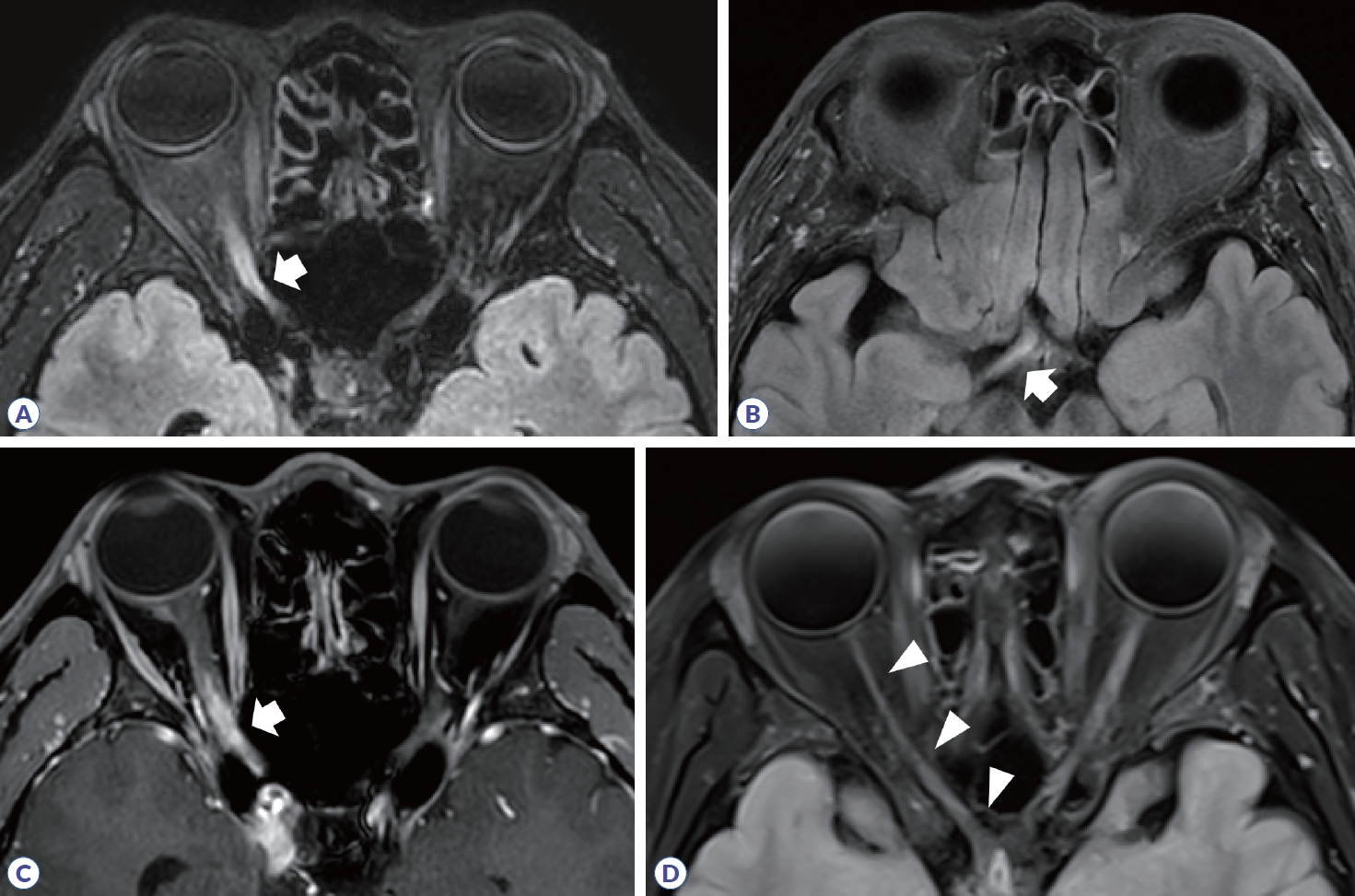
Figure┬Ā3.
Orbit MRI in myelin oligodendrocyte glycoprotein antibody-associated disease. (A, B) High signal intensity and gadolinium enhancement are observed in right optic nerve (arrow). (C) In coronary view of T1-gadolinium, perineural enhancement is shown (arrowhead).

Figure┬Ā4.
Brain MRI in multiple sclerosis. (A) Multifocal demyelinating lesions are observed in juxtacortex of right frontal lobe (arrow) and periventricular area (arrowheads). (B) Periventricular lesion in left inferior temporal lobe (arrow). (C) Infratentorial lesion (arrowhead). (D) In chronic phase, T1-black hole due to tissue loss is observed in left frontal lobe (arrow).
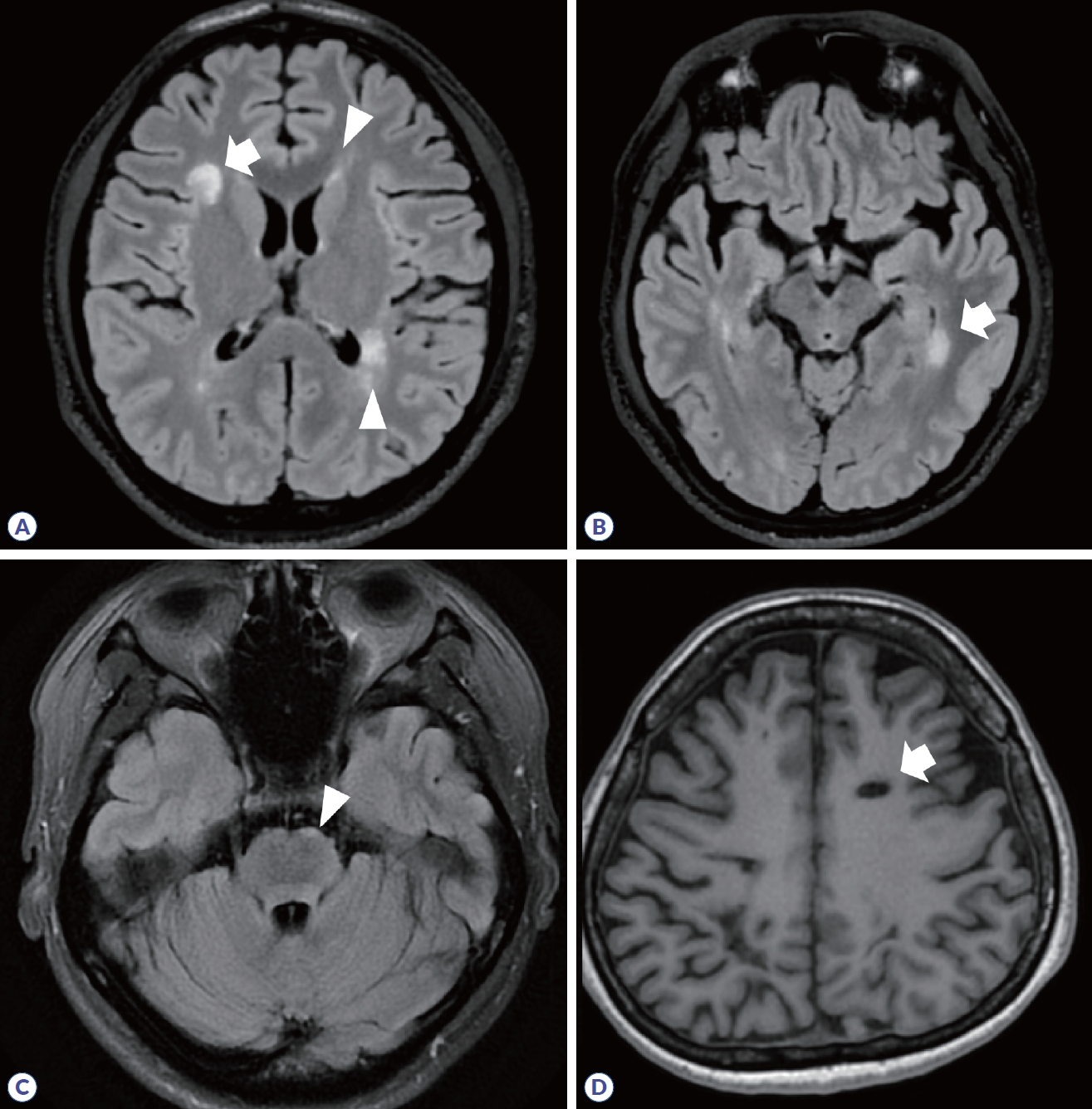
Figure┬Ā5.
Brain MRI in neuromyelitis optica spectrum disorder. High signal intensities in fluid-attenuated inversion recovery are observed in dorsal medulla (A, arrow) and right cerebellum (B, arrowhead).

Figure┬Ā6.
Brain MRI in myelin oligodendrocyte glycoprotein antibody-associated disease. (A, B) Multifocal, confluent ŌĆśfluffyŌĆÖ lesions (arrows) are observed in frontal, parietal, and temporal subcortical white matter. (C, D) Nodular enhancing lesions in left temporal lobe, and fuzzy linear and nodular enhancing lesion in right frontal white matter are observed (arrowhead).
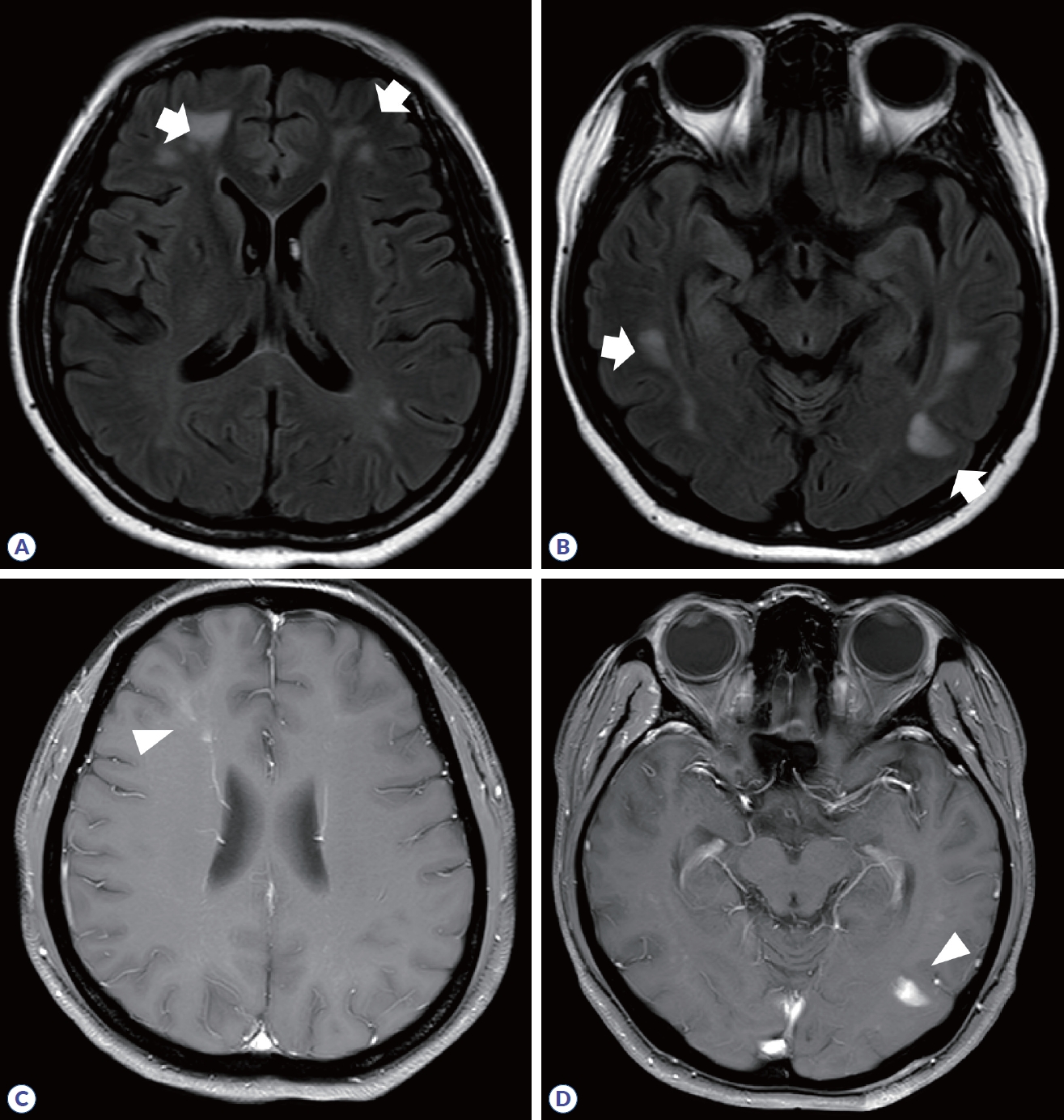
Figure┬Ā7.
Spine MRI in multiple sclerosis. (A) High signal intensity is observed in C3 segment in sagittal T2 weighted image (arrow). (B) Axial T2 weighted image show that the lesion is located in the right peripheral area. (C) Homogenous enhancement is shown in T1 gadolinium enhancement.
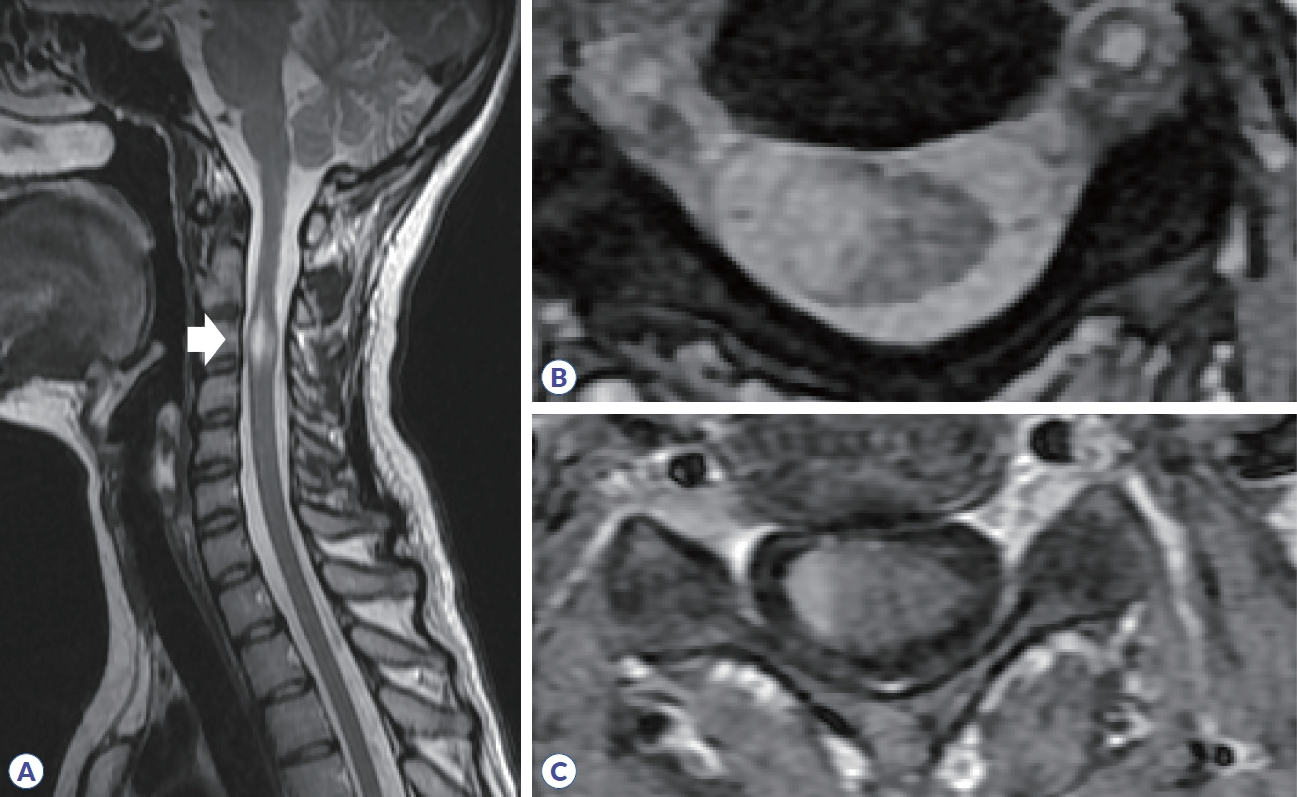
Figure┬Ā8.
Spine MRI in neuromyelitis optica spectrum disorder. (A) Longitudinally extensive transverse myelitis (from C7 segment to T7 segment, arrows) is observed in sagittal T2 weighted image. (B) Axial image shows that the lesion is centered in the spinal cord and occupies most of the cross-section area.
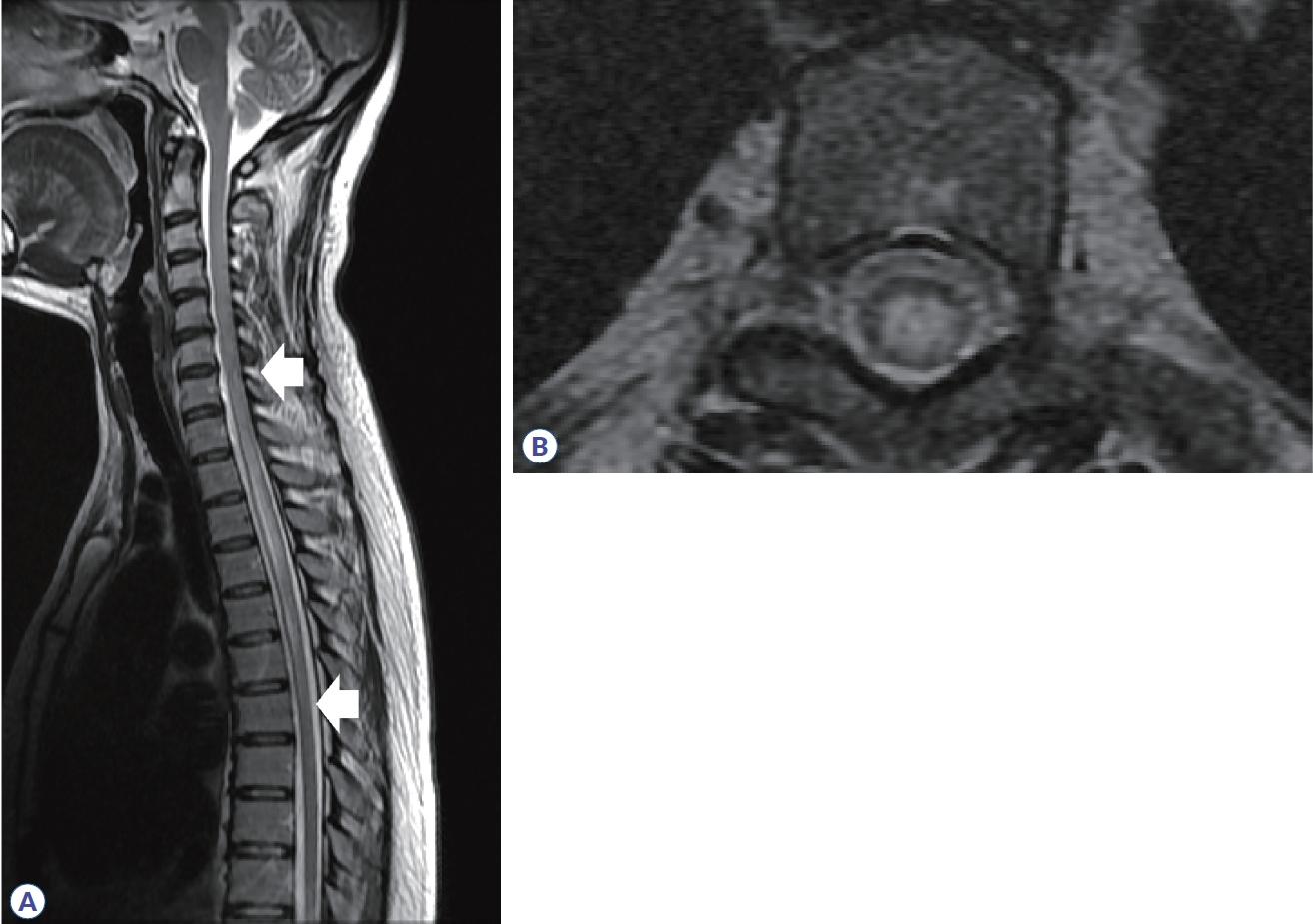
Table┬Ā1.
Characteristics of magnetic resonance imaging in optic neuritis among MS, NMOSD, and MOGAD
Table┬Ā2.
Characteristics of magnetic resonance imaging in brain lesion among MS, NMOSD, and MOGAD
Table┬Ā3.
Characteristics of magnetic resonance imaging in myelitis among MS, NMOSD, and MOGAD
REFERENCES
1. Van Mater H. Pediatric inflammatory brain diseases: a diagnostic approach. Curr Opin Rheumatol 2014;26:553-561.

2. Tillema JM. Imaging of central nervous system demyelinating disorders. Continuum (Minneap Minn) 2023;29:292-323.


4. Akaishi T, Nakashima I, Takeshita T, Kaneko K, Mugikura S, Sato DK, et al. Different etiologies and prognoses of optic neuritis in demyelinating diseases. J Neuroimmunol 2016;299:152-157.


5. Ramanathan S, Prelog K, Barnes EH, Tantsis EM, Reddel SW, Henderson AP, et al. Radiological differentiation of optic neuritis with myelin oligodendrocyte glycoprotein antibodies, aquaporin-4 antibodies, and multiple sclerosis. Mult Scler 2016;22:470-482.



6. Filippi M, Rocca MA. Magnetization transfer magnetic resonance imaging of the brain, spinal cord, and optic nerve. Neurotherapeutics 2007;4:401-413.



7. Hickman SJ, Toosy AT, Jones SJ, Altmann DR, Miszkiel KA, MacManus DG, et al. Serial magnetization transfer imaging in acute optic neuritis. Brain 2004;127:692-700.


8. Cortese R, Prados Carrasco F, Tur C, Bianchi A, Brownlee W, De Angelis F, et al. Differentiating multiple sclerosis from AQP4-neuromyelitis optica spectrum disorder and MOG-antibody disease with imaging. Neurology 2023;100:e308-e323.



9. Petzold A, de Boer JF, Schippling S, Vermersch P, Kardon R, Green A, et al. Optical coherence tomography in multiple sclerosis: a systematic review and meta-analysis. Lancet Neurol 2010;9:921-932.


10. Chen JJ, Sotirchos ES, Henderson AD, Vasileiou ES, Flanagan EP, Bhatti MT, et al. OCT retinal nerve fiber layer thickness differentiates acute optic neuritis from MOG antibody-associated disease and multiple sclerosis: RNFL thickening in acute optic neuritis from MOGAD vs MS. Mult Scler Relat Disord 2022;58:103525.


11. Rogaczewska M, Michalak S, Stopa M. Differentiation between multiple sclerosis and neuromyelitis optica spectrum disorder using optical coherence tomography angiography. Sci Rep 2021;11:10697.




12. Thompson AJ, Banwell BL, Barkhof F, Carroll WM, Coetzee T, Comi G, et al. Diagnosis of multiple sclerosis: 2017 revisions of the McDonald criteria. Lancet Neurol 2018;17:162-173.

13. Hemond CC, Bakshi R. Magnetic resonance imaging in multiple sclerosis. Cold Spring Harb Perspect Med 2018;8:a028969.



14. Sechi E, Cacciaguerra L, Chen JJ, Mariotto S, Fadda G, Dinoto A, et al. Myelin oligodendrocyte glycoprotein antibody-associated disease (MOGAD): a review of clinical and MRI features, diagnosis, and management. Front Neurol 2022;13:885218.



15. Salama S, Khan M, Shanechi A, Levy M, Izbudak I. MRI differences between MOG antibody disease and AQP4 NMOSD. Mult Scler 2020;26:1854-1865.




16. Kim HJ, Paul F, Lana-Peixoto MA, Tenembaum S, Asgari N, Palace J, et al. MRI characteristics of neuromyelitis optica spectrum disorder: an international update. Neurology 2015;84:1165-1173.


17. Banwell B, Bennett JL, Marignier R, Kim HJ, Brilot F, Flanagan EP, et al. Diagnosis of myelin oligodendrocyte glycoprotein antibody-associated disease: International MOGAD Panel proposed criteria. Lancet Neurol 2023;22:268-282.


18. Jurynczyk M, Tackley G, Kong Y, Geraldes R, Matthews L, Woodhall M, et al. Brain lesion distribution criteria distinguish MS from AQP4-antibody NMOSD and MOG-antibody disease. J Neurol Neurosurg Psychiatry 2017;88:132-136.


19. Harrison DM, Oh J, Roy S, Wood ET, Whetstone A, Seigo MA, et al. Thalamic lesions in multiple sclerosis by 7T MRI: clinical implications and relationship to cortical pathology. Mult Scler 2015;21:1139-1150.




20. Cagol A, Cortese R, Barakovic M, Schaedelin S, Ruberte E, Absinta M, et al. Diagnostic performance of cortical lesions and the central vein sign in multiple sclerosis. JAMA Neurol 2024;81:143-153.



21. Maggi P, Sati P, Nair G, Cortese ICM, Jacobson S, Smith BR, et al. Paramagnetic rim lesions are specific to multiple sclerosis: an international multicenter 3T MRI study. Ann Neurol 2020;88:1034-1042.




22. Matsumoto Y, Misu T, Mugikura S, Takai Y, Nishiyama S, Kuroda H, et al. Distinctive lesions of brain MRI between MOG-antibody-associated and AQP4-antibody-associated diseases. J Neurol Neurosurg Psychiatry 2021;92:682-684.

23. Sechi E, Krecke KN, Messina SA, Buciuc M, Pittock SJ, Chen JJ, et al. Comparison of MRI lesion evolution in different central nervous system demyelinating disorders. Neurology 2021;97:e1097-e1109.



25. Hyun JW, Kim SH, Jeong IH, Lee SH, Kim HJ. Bright spotty lesions on the spinal cord: an additional MRI indicator of neuromyelitis optica spectrum disorder? J Neurol Neurosurg Psychiatry 2015;86:1280-1282.


26. Hyun JW, Lee HL, Park J, Kim J, Min JH, Kim BJ, et al. Brighter spotty lesions on spinal MRI help differentiate AQP4 antibody-positive NMOSD from MOGAD. Mult Scler 2022;28:989-992.



27. Dubey D, Pittock SJ, Krecke KN, Morris PP, Sechi E, Zalewski NL, et al. Clinical, radiologic, and prognostic features of myelitis associated with myelin oligodendrocyte glycoprotein autoantibody. JAMA Neurol 2019;76:301-309.



28. Mariano R, Messina S, Roca-Fernandez A, Leite MI, Kong Y, Palace JA. Quantitative spinal cord MRI in MOG-antibody disease, neuromyelitis optica and multiple sclerosis. Brain 2021;144:198-212.



29. Casserly C, Seyman EE, Alcaide-Leon P, Guenette M, Lyons C, Sankar S, et al. Spinal cord atrophy in multiple sclerosis: a systematic review and meta-analysis. J Neuroimaging 2018;28:556-586.



30. Tobin WO, Guo Y, Krecke KN, Parisi JE, Lucchinetti CF, Pittock SJ, et al. Diagnostic criteria for chronic lymphocytic inflammation with pontine perivascular enhancement respon-sive to steroids (CLIPPERS). Brain 2017;140:2415-2425.





 PDF Links
PDF Links PubReader
PubReader ePub Link
ePub Link Full text via DOI
Full text via DOI Download Citation
Download Citation Print
Print



